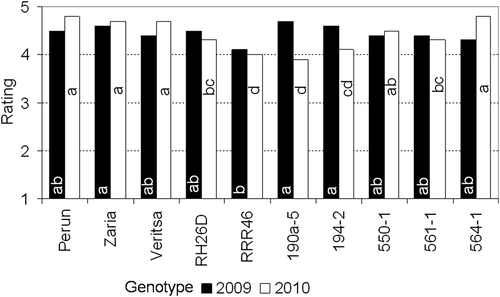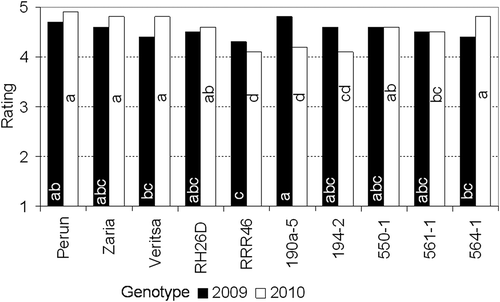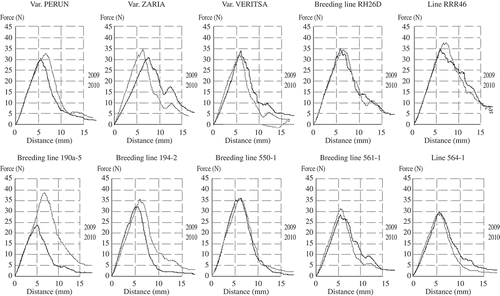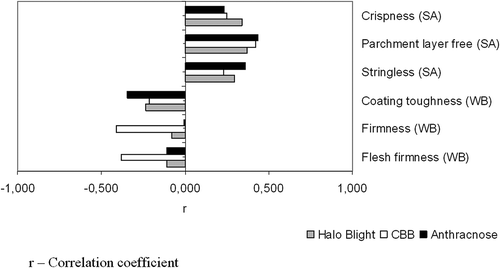Abstract
A recent study aimed to establish the correlation between instrumental (using Stable Micro System Texture Analyzer) and sensory texture analyses assays in snap bean pods (Phaseolus vulgaris L.). The rupture force correlated significantly and negatively with the sensory traits: parchment layer free, crispness, and stringlessness. Firmness measurements of the raw pods by the texture analyzer indirectly gave enough information to use it as a tool for sensory texture analyses of the processed beans. This could allow breeders to evaluate textural quality of cooked pods in the early stages of the breeding and selection program, thus saving time and costs in doing sensory texture analysis.
INTRODUCTION
Beans are a common part of the traditional Bulgarian diet. Consumers prefer snap beans for their nutritional value as well as for the specific sensorial characteristics. According to Bourne,[Citation1] two of the principal quality factors in foods are flavor and texture. Texture is an essential human experience arising from our contact with food.[Citation2] From a sensory point of view, this property is generally defined as the overall feeling that food leaves in the mouth after consumption and is, therefore, comprised of properties that can be evaluated by touch.[Citation3] Concerning vegetables, this property is affected by various traits such as cellular organelles and biochemical components, water content, and cell wall composition.[Citation4]
Texture is a very important indicator of green bean product quality for consumers and it is the parameter that is most obviously changed when pods are canned or frozen. Concerning boiled green beans, texture is a result of complex interactions among several components including firmness, crispness, parchment layer free, stringlessness, succulence, etc. Genotype x pathogen interactions also play a significant role on texture quality in the snap bean. In order to achieve bean lines and varieties with improved resistance toward pathogens, numerous crosses, selections, and progeny screenings were made.[Citation5,Citation6] As recombinogenesis is a major source of genetic variability, it could either deteriorate or improve fruit texture in resistant genotypes. In an earlier study, it was proved occasionally that due to recombinogenesis in the progeny: (1) a great part of the negative properties of the resistance sources were eliminated; and (2) the organoleptic properties of the pods were improved to a considerable extent.[Citation7]
The goal is to develop snap bean varieties with improved texture quality. Therefore, it is crucial to have precise, repetitive, and reproducible tools to study and monitor the textural changes in the breeding process. Food texture can be measured using either sensory or instrumental methods. Sensory evaluation is the only direct evaluation method, and it can be compared with indirect instrumental measurements.[Citation8CitationCitation−Citation11] There has been a great interest in the development of instrumental methods to evaluate the texture of plant-based foods. Instrumental texture analyses are applied to measure firmness in green beans using different devices.[Citation12Citation−Citation14] Several statistically significant correlations are reported in the literature between sensory and instrumental measurements.[Citation15,Citation16] Still no comparison is made between these two methods for evaluation of pod quality in snap bean breeding.
In this article the texture of snap bean cultivars was comparatively assessed using both instrumental and sensory analyses with the objectives of (1) evaluating the level of correlation between the two methods, and (2) to selecting the most appropriate genotypes with better texture quality in order to use them as parents in the breeding program.
MATERIAL AND METHODS
Plant Material
Snap bean (Phaseolus vulgaris L.) varieties and recombinant inbred lines (RILs) with a wide range of textural characteristics have been selected during the last decade at Maritsa Vegetable Crops Research Institute (VCRI) and have been analyzed for their agricultural properties, productivity, and disease resistance. Ten snap bean round-poded releases were chosen specifically for their morphological characters, market quality, and disease resistance: three varieties locally known as Zaria, Perun, and Veritsa;[Citation17,Citation18] breeding lines 190a-5, 194-2, 550-1, 561-1, 564-1; and plant introductions from Versailles, France RRR46 and RH26D. The breeding lines were released for machinery harvesting by the bean breeding group at Maritsa VCRI. They possess multiple disease resistance and round green pods with superior pod quality. When the lines were developed, all of them were screened for resistance toward halo blight and common bacterial blight using previously described screening procedures.[Citation19Citation−Citation21] ().
TABLE 1 Multiple disease resistance of garden bean varieties and lines
Field production trials
Studies were conducted at the “Maritsa” VCRI, Plovdiv in 2009 and 2010. Untreated bean seeds were hand planted on the field on the last week of April. The experimental design was a randomized complete block with four replications of field experimental plots measuring 4.8 m2. Weeds were controlled with broadcast preplant—incorporated application of conventional herbicide supplemented by hand and machine cultivation in both years. Plant water requirements were met with dropping irrigation system. Standard foliar insecticides were applied as needed.
Sensory Panel Design for Texture
Each accession was harvested by hand one time at prime maturity by pulling up and depending all plants in 3 m of each plot. Harvest maturity was determined (1) when the length of the middle seed in a mature pod is equal to or greater than 1 cm,[Citation22] and (2) by determining dry matter content of random sample of 500 g fresh pods.[Citation23] Pods were weighed and a random sample of 300 g or greater was taken. Twenty-five relatively straight pods per plot were tested to confirm that all fit sieve size 4.[Citation24] Samples were washed in tap water (21°C) right after harvesting, cut into pieces 3 cm long, and boiled for 12 min without added salt and then immediately cooled in 15°C water for 2 min. A four-member panel trained for canned snap beans conducted sensory analyses for crispness (C-SA), parchment layer free (PLF-SA), and stringlessness (S-SA) by following a descriptive method adapted for green beans. The sensory descriptors were:
Crispness: 5– extremely soft and very easy breaking pods; 1– extremely crisp and very hard breaking pods;
Parchment layer free: 5– total lack of parchment layer; 1– well formed, thick and tough parchment layer;
Stringlessness: 5– total lack of fiber and string; 1– very well visible fiber and tough double string.
A five-point quality differential scale with 0.25-step increments was used.
Instrumental Testing Design for Texture
Bean texture was determined using a Stable Micro System, texture analyzer; model TA.XT.Plus (Godalming, Surrey, UK). A force-deformation curve was obtained with slow deformation using a Warner-Bratzler blade (WB) test. A randomized sample of ten pods from each bean accession were analyzed right after harvesting. A single bean pod was placed to span the slot and cut in half between two immature seeds by the blade. The blade penetrated the bean pod on its side where there is not suture. The instrument was set at a test speed of 1 mm s−1 and a travel distance of 30 mm. Yield force (F1), rupture force (F2), negative force peak (F3), yield deformation (D1), rupture deformation (D2), total deformation (D3), and the total area (A) under the force/distance curve were recorded during the cutting operation ().
Statistical Analysis
Sensory scores and the WB test results were processed with SPSS statistical package-version 12, using Duncan’s multiple range tests,[Citation25] at the 5% significance level. Variation and correlation analysis between sensory scores and the WB test results were made using MS Excel, 7 software (Microsoft Systems 2007). Two-way analysis of variance by SPSS software, version 12 was used to process the instrumental test results.
RESULTS AND DISCUSSION
Sensory Panel Analyses
The green bean samples were harvested at times close to the market maturity stage when determining the value of dry matter content of the pods (). Therefore, hereby established differences in sensory properties are probably due to the genotype effect rather than to dry matter content. The low correlations between dry matter content and sensory evaluation for crispness (r = –0.005), parchment layer free (r = –0.058), and stringlessness (r = –0.008) confirmed this assumption.
FIGURE 2 Dry matter content in snap beans. a, b, c: Degree of significance at P ≤ 0.05 by Duncan’s Multiple Range Test.
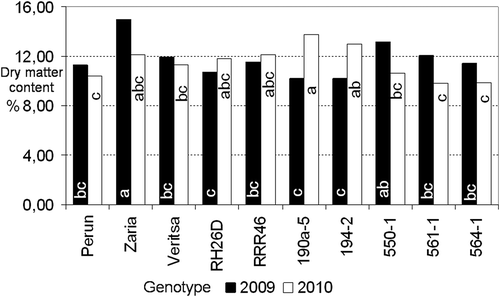
The sensory evaluations for crispness were stable for the predominant part of the studied varieties and lines during the experimental period (). Assessments’ amplitude of over 0.5 was only recorded in three lines (190a-5, 194-2, and 564-1). Varieties Perun and Zaria obtained highest scores from the panelists in respect to crispness.
FIGURE 3 Sensory evaluation for crispness in snap beans. a, b, c: Degree of significance at P ≤ 0.05 by Duncan’s Multiple Range Test.
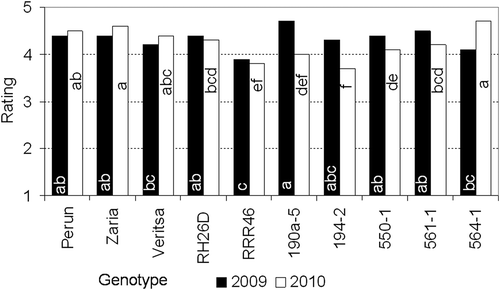
Parchment layer free is a very important trait concerning sensory quality of fresh snap bean pods. In comparison with crispness, this parameter was more variable. The assessments reached nearly the maximum during the second year for the three varieties and line 564-1 (). All bean samples obtained high scores (over 4.0) for stringlessness (). Most pods had no string at all or if there was some, it was tender enough not to affect the quality perception.
WB Test
Based on the stress deformation curve for bean samples () it was assumed that: (1) rupture force (F2) was an indicator for pod firmness (PF-WB); (2) young modulus was calculated after the formula F1/D1 and defined the textural parameter coating toughness (CT-WB); (3) formula was used for the evaluation of flesh firmness (FF-WB). Insignificant correlations between the dry matter content and instrumental evaluation of coating toughness (r = –0.152), firmness (r = –0.259), and flesh firmness (r = –0.052) were observed. This result shows that harvest maturity did not disguise the genotype influence.
Coating toughness within the lines was the least variable trait during the experimental period (). Comparatively low coefficients of variability (CV) indicated that the breeding lines possessed good uniformity concerning this parameter. The lowest CV scores were recorded in six accessions (190a-5, 194-2, 550-1, 561-1, 564-1, and Veritsa) in both years. Higher amplitudes between mean values of the samples were observed in the first experimental year compared to the second one. Genotype x environment interaction was moderately high and statistically significant (). The genotype influence was greater than the environment effect.
TABLE 2 Textural parameters of garden beans measured by texture analyzer
FIGURE 6 Two-way analysis of variance for textural parameters from instrumental analysis in snap beans in dependence of genotype (factor A) and environmental conditions (factor B). Factor A: genotype; Factor B: environmental conditions; *P = 5%; **P = 1%; ***P = 0.1%; ns: not significant.

Regarding firmness most of the lines were uniform as well, confirmed by the relatively low CV within the samples, ranging from 10.10 to 24.85 %; the only exception was line RRR46 (). According to Bourne,[Citation1] firmness is the primary texture property in piece-form vegetables. This parameter is considered very similar to the masticatory action. Comparatively high and stable mean values over 40 N were recorded in line RRR46 against lower mean values for the three varieties and lines 561-1 and 564-1 (). This genotype effect was confirmed by the two-way analysis of variances ().
Flesh firmness was the most variable intra-variety parameter in both years with CV reached to 46.26% in line 190a-5 (). This could be because flesh firmness is most related to the energy necessary for complete breaking of the pod. Nevertheless, varieties Perun and Zaria, and lines 550-1, 561-1, and 564-1 could be considered more uniform than the others could. Relatively high mean values over 100 N mm were found in line RRR46. Genotype influence of flesh firmness was almost two times greater than the influence on coating toughness and firmness ().
Having in consideration that no selection with set purpose on above described texture parameters had been done during the breeding process for disease resistance, the uniformity of the studied samples overall was not high enough. The obtained force-deformation curves were of specific design due to the different genotypes (). The slight changes of the curve inclination in most of the samples between both experimental years clearly showed that the genotype effects had greater influence than the environmental ones. Breeding line 190a-5 was the only exception that showed a noticeable increase in rupture force during 2010 compared to 2009. Line 194-2 had slight differences of the curves mainly in rupture point position.
The specific curve design was more expressed in the area under the force/distance curve recorded between the maximum point (rupture force) and the negative peak (F3). The curves of inclination for line RRR46 were lower than the inclination of the curves for all the other samples. During the cutting operation some difficulties were observed in blade penetration into the pod flesh which was caused by the presence of the tougher parchment layer of RRR46. The decreased slope of the curves for line RRR46 clearly corresponded to the tougher parchment layer, additionally confirmed with the lowest sensory evaluations for parchment layer free and crispness.
Correlation Analysis
Simple correlations among the studied parameters were evaluated in order to accelerate the process of snap bean quality evaluation. One strong positive correlation was found in texture parameters measured instrumentally, () firmness correlated significantly with flesh firmness. Similar results were recorded by Leadley et al.[Citation26] The authors had observed a strong correlation between peak slicing force (here named “firmness”) and the area under the force distance curve (here named “flesh firmness”). Therefore, they had concluded that the rupture force could be used as the primary indicator of bean texture firmness.
TABLE 3 Correlation coefficients between sensory and instrumental parameters
Significant correlations between sensory and instrumental parameters were found () which corresponds with other findings in vegetables.[Citation16] In the present work, moderate to strong negative correlations were established between crispness, parchment layer free, and stringlessness from sensory analysis and firmness from the instrumental one (). These results confirm Bourne’s statement,[Citation1] that firmness is most used in quantifying kinetics of texture degradation of vegetables because it best relates to the consumer perception. This fact has significant meaning for the process of assessment of snap bean pods right after harvesting and avoiding thermal processing. Firmness measurement of the raw pods using the texture analyzer would indirectly give enough acceptable information about the sensory quality concerning the texture of the processed beans. Based on the defined regression equations where firmness is a constant (x) it could predict the values of the variables crispness (y1), parchment layer free (y2), and stringlessness (y3; ). Therefore, it is appropriate to measure texture quality of raw pods using firmness when quality of the product is a major breeding goal. That would avoid sensory analysis on processed products and would give breeders the opportunity to screen larger amount of breeding accessions saving time and costs.
TABLE 4 Regression analysis
Some interesting relations were found considering the breeder’s point of view. Significant correlations of disease resistance evaluations for halo blight and common bacterial blight with the studied sensory and instrumental textural parameters in snap beans were not established (). Nevertheless, some tendencies were observed. Variety Zaria, which has no resistance to both diseases, obtained high sensory evaluations () and comparatively low values for the instrumental textural parameters (). Breeding line RRR46 carrying resistance toward the above-mentioned diseases was given the lowest sensory evaluations combined with the highest average values of both years for firmness and flesh firmness measured instrumentally. However, the presence of weak correlations shows that there is a real possibility to develop new garden bean varieties with both good sensory quality and multiple disease resistance.
CONCLUSIONS
The instrumental textural analysis is an objective precise and reproducible tool to study and monitor the quality of raw snap bean pods. The studied textural parameters are genetically determined and environmentally influenced that is very much considered from breeding view-point. The observed high correlations showed relationships among the sensorial and instrumental texture parameters. These results could allow relating sensory quality of pod texture with rupture force—the indicator for pod firmness. It is possible to screen cultivars for better sensory quality combined with multiple disease resistance, indirectly based on the consumer’s preference.
FUNDING
This research was implemented with the financial support of the 7 Framework Program of the European Commission under grant no. 205 941 “Balkan vegetable research centre for transfer of European knowledge, research and practice.”
Additional information
Funding
REFERENCES
- Bourne, M.C. Texture evaluation of horticultural crops. HortScience 1980, 15, 51–56.
- Rosenthal, A.J. Relation between instrumental and sensory measurement of food texture. In: Food Texture, Measurement, and Perception; Rosenthal A.J.; Ed.; A Chapman & Hall, Aspen Publication: Gaithersburg, MD, 1999; 1–17.
- Sams, C.E. Preharvest factors affecting postharvest texture. Postharvest Biology And Technology 1999, 15, 249–254.
- Guinea, R.P.F.М.; Barroca, M.J. Influence of freeze-drying treatment on the texture of mushrooms and onions. Croatian Journal Of Food Science And Technology 2011, 3 (2), 26–31.
- Genchev, D.; Kiryakov, I.; Beleva, M. Beslet- A new dry bean variety (Phaseolus Vulgaris L.). Plant Science 2010, 47, 272–281.
- Sofkova, S.; Poryazov, I.; Kiryakov, I. Breeding green beans (Phaseolus Vulgaris L.) for complex disease resistance. Genetics and Breeding 2010, 38 (3–4), 79–90.
- Pevicharova, G.; Poryazov, I. Sensory analysis of breeding material from garden bean resistant to acantoscelides obtectus. Annual Report of the Bean Improvement Cooperative 2003, 46, 133–134.
- Wang, C.R.; Chang, K.C; Grafton, K. Canning quality evaluation of pint and navy beans. Food Technology–Chicago 1988, 53 (3), 772–776.
- El-Moniem, G.M.A. Sensory evaluation and in vitro protein digestibility of mung bean as affected by cooking time. Journal of The Science of Food and Agriculture 1999, 79 (14), 2025–2028.
- El-Moniem, G.M.A.; Honke, J.; Bednarska, A.A. Effect of frying various legumes under optimum conditions of amino acids, in vitro digestibility and oligosaccharides. Journal of the Science of Food and Agriculture 2000, 1, 57–62.
- Szczesniak, A.S. Texture is a sensory property. Food Quality and Preference 2002, 13, 215–225.
- Bay, A.P.M.; Bourne, M.C.; Taylor, A.G. Effect of moisture content on compressive strength of whole snap bean (Phaseolus Vulgaris L.) seeds and separate cotyledons. Journal of Food Engineering 1996, 31 (4), 327–331.
- Stolle-Smits, T.; Beekhuizen, J.G.; Recourt, K.; Votagen, Z.G.J; Van Dijk, C. Preheating effects on the textural strength of canned garden beans. 1. cell wall chemistry. Journal of Agricultural and Food Chemistry 2000, 48 (11), 5269–5277.
- Ferreira, A.; Canet, W.; Alvarez, D.; Tortosa, E. Freezing, thawing, and cooking effects on quality profile assessment of green beans (Cv. Win). European Food Research and Technology 2006, 223 (4),433–445; Berlin: Springer-Verlag Gmbh.
- Meullene, J.F.; Carpenter, J.A.; Lyon, B.G.; Lyon, C.E. Bi-cyclical instrument for assessing texture profile parameters and their relationship to sensory evaluation of texture. Journal of Texture Studies 1997, 28, 101–118.
- Zsivanovits, G.; Pevicharova, G.; Velkov, N. Genotypic response of melon to texture parameters and sensory quality. Proceedings of International Scientific-Practical Conference Food, Technologies, & Health; Plovdiv, Bulgaria, November 8, 2012; 17–22.
- Poryazov, I.; Mihov, A.; Kovachev, A.; Manuelyan, H.; Velev, S. Cultivar Zarya—New garden bean cultivar for mechanized harvesting. Horticulture and Viticulture Science 1984, 8, 58–62.
- Poryazov, I. Veritsa, Fiesta, and Peroun. Plant Science 1989, 10 (26), 50–53.
- Mills, L.J.; Silbernagel, M.J. A rapid screening technique to combine resistance to halo blight and bean common Mosaic virus in Phaseolus Vulgaris L. Euphytica 1992, 58, 201–208.
- Pastor-Corrales, M.A.; Otoya, M.A.; Molina, A.; Singh, S.P. Resistance to Colletotrichum Lindemuthianum isolates from Middle America and Andean South America in different common bean races. Plant Disease 1995, 79, 63–67.
- Zapata, M.; Freytag, G.F.; Wikinson, R.E. Evaluation for bacterial blight resistance in beans. Phytopathology 1985, 75,1032–1039.
- Silbernagel, M.J. Seed quality index as an indicator of crop production potential, and a selection tool for the genetic improvement of snap bean seed quality. Annual Reports of the Bean Improvement Cooperative 1979, 20, 40–42.
- Manuelyan, H. Study on the drying samples in determining dry matter content of some vegetables. Horticulture and Viticulture Science (Bul.) 1966, 6, 723–730.
- Rutledge, A.D. PB897-Commercial snap bean production. The University of Tennessee Agricultural Extension Service 1996, PB897-1M-10/95(Rev) E12-2015-00-291-95.
- Duncan, D. Multiple range and multiple F-tests. Biometrics 1955, 11, 1–42.
- Leadley, C.; Tucker, G.; Fryer, P. A comparative study of high-pressure sterilization and conventional thermal sterilization: Quality effects in garden beans. Innovative Food Science and Emerging Technologies 2008, 9, 70–79.

![FIGURE 1 Stress deformation curve obtained after using simple rupture test. F1–Yield Force [N]; D1–Yield Deformation [mm]; Y–Young modulus [N/mm]=F1/D1; F2–Rupture Force [N]; D2–Rupture Deformation [mm]; F3–Negative Force Peak [N]; D3–Total Deformation [mm]; A – Flesh firmness [N.mm] =.](/cms/asset/e6bfcb5c-bf5e-43aa-b832-39747655c4f9/ljfp_a_891610_f0001_oc.jpg)
